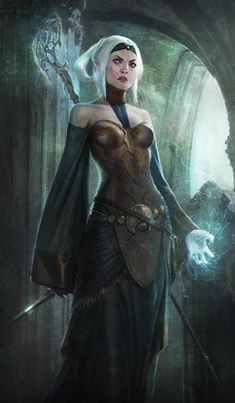- For the class in specific games, see Mage (Origins), Mage (Dragon Age II), Mage (Inquisition) and Mage (The Veilguard).
The mage is a playable class in Dragon Age: Origins, Dragon Age Journeys, Dragon Age: Origins - Awakening, Dragon Age Legends, Dragon Age II, Dragon Age (tabletop RPG), and Dragon Age: Inquisition. Mages are able to use, control and interact with magic. Only elves, humans, or Qunari can be mages. Dwarves cannot be mages, as they are unable to connect with the Fade. This is due to their prolonged exposure to lyrium, which has granted them a natural resistance to magic. While surface dwarves lose their resistance over time, no dwarf has ever been known to wield magic.[1]
Characteristics[]
“A mage is fire made flesh and a demon asleep” ―a saying[2]
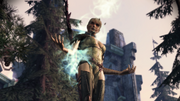
Velanna spellcasting.
In Thedas, magic is a natural physical phenomenon such as gravity or magnetism. Some people are born with the ability to interact with, control, and shape it. As magic tends to run in bloodlines, the Tevinter Imperium kept extensive genealogies of all families known to produce magical talent. Eventually, several social classes of mages were established in Tevinter, from the "Altus," upper class mages said to be descendants of the Dreamers of Ancient Tevinter, to the "Laetan," born into non-mage families or families with no link to the higher Altus or Dreamer class.[3]
Conventional magic originates from the Fade, the realm where spirits dwell and where humans, qunari, and elves visit when they dream. For non-mages, entering the Fade while dreaming is a fleeting and inconsequential experience but mages have a greater awareness of their dreams. Generally, only those who use lyrium to enter the Fade are able to separate their dreams from reality.[4] Mana is a measurement of one's ability to channel energy from the Fade, and this energy is expended in the practice of magic. Just as the Fade can be reshaped by those who have grasped its nature, so can the world of Thedas be manipulated by magic via willing things into being. The ability of a living being to expend mana is what defines a mage[5][6] and certain people are born with this potential, although no one knows the reason why.
The act of drawing power from the Fade can draw the attention of the spiritual beings on the other side of the Veil. Some people say that spirits, particularly demons, are drawn to the dreams of those who possessed magic like moths to a flame.[7] These encounters with demons consequently lead to an increased risk of demonic possession if the mages are not vigilant enough. A possessed mage becomes a distortion of their former self, a twisted monster known as an abomination that has enough power to wipe entire villages off the map. It is for this reason that a mage must have enough willpower to master their magic so they can resist demons while they are "awake" in the Fade. Additionally, mages must have the good sense to block the whispering temptations of demons whenever mages are in communication with them.
With the proper training, mages are capable of manipulating the basic elements, such as conjuring gouts of flame and small, localized ice and electrical storms. There are also spells that allow for the temporary reanimation of corpses and the draining of an opponent's life-force. More altruistic mages can use their powers to help and heal, or summon benevolent spirits in times of need. Though they are often ostracized to the point of persecution, mages are key for everyday life in Thedas. They serve as its healers, scholars, scientists, and weapons of war.
Mages who possess the rare talent of detecting and communicating with demons and spirits are called spirit mediums. Rhys is known to be a spirit medium.[8]
There are limitations to the application of magic, however. Just as a man has the strength to lift only so much weight and no more, a mage cannot work more magic at one time than his mana allows. If he wishes to work magic that would be beyond his strength, a mage must bolster his mana with lyrium. Without lyrium, it is possible for the reckless to expend their own life-force in the working of magic, and occasionally, ambitious apprentices injure or even kill themselves by over-exertion.[6]
Teleportation, resurrection (under normal circumstances) [9] and physically entering the Fade (in the absence of a great deal of lyrium and potentially the aid of blood magic) are not possible.[10] Magic also cannot prevent a potentially fatal incident such as falling from a building.[11] Furthermore, the powers of a mage require a direct line of sight to a target, and have a limited range.[12]
There are two schools of magic that bear no connection to the Fade: blood magic, which draws power directly from blood, and blight magic, which is driven by the taint.
The working of magic[]
The Fade sticks to mages like little figments that are flitting and floating free around them. Mages take that Fade energy that clings to them and force it into shapes in the form of magical spells that produce phenomena like fire, ice, and lightning.[13] A mage uses magic by tapping into the power of the Fade to essentially question reality, rendering it mutable and able to be reshaped. To this end, templars are the ideal foils for mages, having been trained specifically to counter and "deny" magic.[14] This is done by a unique method of reinforcing the reality and immutability of the world. Like a door being slammed in the mage's face, magical effects dissipate and the mage is unable to reshape a suddenly stubborn world. From a mage's perspective it appears to be less spell interruption and more a templar reinforcing a reality in which that spell cannot be cast in the first place.[15] Cole offers a different explanation for the powers of the templars: after ingesting lyrium their bodies become incomplete and try to connect to something older and bigger than they are. They reach for that "other thing" and magic has no room to come in.[16]
Onset of magic[]
Magic is considered an innate ability but it's not apparent from birth. Magical talent typically surfaces around puberty,[17][18] though the age of onset falls within a wide range. The ability can manifest in multiple ways, from subtle signs like a change in eye colour to devastating displays of power. A sudden onset of magic may be confusing to the wielder.[17]
Age and manner of onset, from youngest to oldest:
- Merrill – 4 years old[19]
- Orana – 5 years old[20]
- Jowan – 5 or 6 years old[21]
- Emile de Launcet - 6 years old[22]
- Minaeve – 7 years old[23]
- Feynriel – 8 years old; made a houseplant bloom in the midst of winter[24]
- Bethany Hawke – 9 years old; threw a bully across a field without touching him[25]
- Lysas – 9 years old[26]
- Olivia – 9 years old[27]
- Velanna – 9 years old; summoned a small, controlled flame[28]
- Wynne – 9 years old;[29] set a boy on fire in response to bullying[30][31]
- Talwyn – 10 years old[32]
- Rhys – 11 years old[33]
- Anders – 12 years old; accidentally set a barn on fire with magic[34]
- Cole – 12 years[35]
- Fiona – 14 years old; killed the Orlesian nobleman who enslaved her with raw magical power[36]
- Myrion – 14 years old[37]
In some cases, it's noted that the mage doesn't know how old they were during the onset of magic, possibly due to being too young to remember. Vivienne is said to have been very young when her magic manifested.[38] Dorian Pavus is also said to have been very young when his magic manifested; he was apprenticed to the Carastes Circle of Magi by age nine.[39] Neria's magic manifested before she was nine years old as well.[40]
Types of Magic[]
- Blight
- Blood
- Creation
- Entropy
- Primal
- Spirit
- Force
- Elemental
- Arcane (Arcane Warriors/Knight-Enchanters)
- Nature (Dalish Keepers)
- Necromancy
- Fade
- Healing
- Shapeshifting
History[]
No one knows who first discovered magic, but it has been a part of the world of Thedas for as long as people can remember. From the elves of Arlathan to the mages of Tevinter, both humans and elves have been known to wield magic.
Before it became the Imperium, Tevinter was ruled by a dynasty of kings. And long before the Chantry there was a Circle of Magi: the society of mages in each city. The titles the modern Circles use—enchanter, senior enchanter, first enchanter—all originated here. But above the first enchanter, the Circles of Tevinter had another office: magister.
The magisters formed a council of the most powerful mages in the kingdom. They convened in Minrathous and held dominion over all magic in the land. When Darinius seized the throne in -1195 Ancient, the Court of the Magisters became the royal court, and "magister" was the only title of nobility recognized in Tevinter.[41]
Prior to the Circle’s formation, magic was either practiced by the Magisters of the Tevinter Imperium or in remote areas, knowledge handed down from one generation of practitioners to the next. “Hedge mages,” as Enchanters of the Circle refer to them, or “witches” as legend would name them, do not always employ forbidden magic. Quite often their talents lie in the creation of charms, the use of curses and the ability to change their own forms.[42] Examples of such Hedge mages and witches include the so-called "witches" of the Chasind wilders or the "shamans" of the Avvar barbarians.[43]
In the quest Long Way Home, it is revealed that elves were heavily reliant on magic in the days of Arlathan, and that it is possible that it was they who taught blood magic to the Tevinter magisters. Merrill, for instance, once refers to her blood magic as "the old ways." Legend holds that the first known blood mage, at least for the humans, was a Tevinter: Archon Thalsian. Thalsian was supposedly taught how to use blood magic by the Old God Dumat. Over the years, some historians have argued that this is merely a myth, and that Thalsian learned about blood magic from the elves. Thalsian taught blood magic to others and soon amassed an army, which he used to conquer Elvhenan, the homeland of the elves. This was the start of the Tevinter Imperium, which grew to include most of Thedas, and which worshipped the Old Gods.
The Imperium was not satisfied with control of Thedas, however, and in an incredible act of hubris, the magister lords attempted to enter the Golden City and supposedly usurp the Maker Himself. Their efforts failed, and to punish them, Chantry historians believe that the Maker transformed them into the first darkspawn. These darkspawn fled underground, and eventually found Dumat and transformed him into the first Archdemon. Thus began the First Blight, which would continue for two centuries and greatly weakened the Tevinter Imperium.
In the wake of the First Blight, the people of the Imperium became disillusioned with the Old Gods, and soon began to follow Andraste, a former slave who united the barbarian tribes and led them to break the Imperium's hold on Thedas. Andraste was ultimately betrayed by her husband, Maferath, and burned at the stake, but her death inspired the creation of the Chantry, an event that would alter the face of magic for centuries afterwards.
The Chantry[]
Ten years to the day after Andraste's death, Archon Hessarian converted to the Chant of Light, claiming that he had heard the voice of the Maker when his blade had touched Andraste, and the beginnings of the religion took root. He declared the Maker the one true god, made Andrastianism the religion of the Imperium (i.e., the Imperial Chantry), and publicly revealed Maferath's betrayal. Most of the high-ranking clergy, including nearly all of the ruling Altus magisters, refused to give up their Old Gods, but the non-mage Soporati class overwhelmingly supported Hessarian, beginning a period known as the Transfiguration. With the High Priests dead, Hessarian repurposed the Old God temples into schools for mages.[44]
In 1:20 Divine, the southern Chantry and the Inquisition signed the Nevarran Accord, and created the Circle of Magi in the southern lands, the Templar Order and the Seekers of Truth.[45]
As magic had been the source of the Imperium's power, it was all but banned when the Chantry became the new dominant force in Thedas. Blood magic was completely forbidden, and those who practised any kind of magic were confined. At first, the Chantry detained mages and had them continually light the eternal flame in every chantry in Thedas, with all other forms of magic forbidden. For such powerful beings to only use their powers in such mundane ways, it surprised almost no one when the mages of the Grand Cathedral protested. Divine Ambrosia was surprised and almost ordered an Exalted March on her own Cathedral, until her own templars advised her otherwise.[46] The Circle of Magi was established to regulate the use of magic throughout Thedas, and the Templar Order was founded to police the Circles and capture or eliminate apostate mages.
Modern Thedas[]
Andrastian nations[]
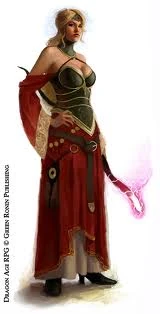
Mage from Dragon Age RPG
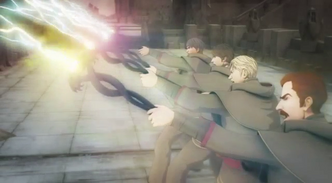
- Main article: Circle of Magi
In the Dragon Age, most mages in Thedas belong to the Circle of Magi. As such, they are taken from their families while still children, and highborn children who are able to use magic will lose all claims to their family's estates and titles when they are taken to the Circle. This helps to create a bond stronger than social class or race, since everybody in the Circle is raised and taught the same way.
Children who are born to mages within the Circle are taken to be raised in a Chantry orphanage, either until they are old enough to make a life on their own (likely within the Chantry itself as a cleric or templar) or their magical abilities have manifested and they are returned to the Circle.[47]
Upon joining a Circle, mages undergo a process as apprentices of having a few drops of their blood taken by the First Enchanter[48] and placed in a phylactery. This ensures the mages' compliance as well as the ability to track down any mage who decides to run away, since a templar can track anyone through their blood. As a further measure, mages who are feared to be incapable of controlling themselves, or who fear their power, are made Tranquil: their connection to the Fade is magically severed along with their emotions and desires.
Though templars insist that the process is painless, the experience appears to be debatable and as unique as the individual who has been rendered Tranquil.[49] The Tranquil are easily identified by their eerie monotone voices, the Chantry sunburst brand on their foreheads, and their emotional apathy, even during life-threatening circumstances. It is worth noting, however, that under normal circumstances there is a reason a mage either is made Tranquil or requests it. Furthermore, imposing the Rite of Tranquility normally requires the agreement of both the Circle Knight-Commander and First Enchanter.[50]
The Harrowing is a test that every mage-apprentice must go through to become a full member of the Circle of Magi. Upon successful completion of their Harrowing, an apprentice is considered a full-fledged mage, capable of defending themselves from demonic possession.
Some mages manage to escape the notice of the Chantry and the Circle, and grow up without the training that those who are taken from their families will have. Any mage not a part of the Circle is considered to be an apostate, and will be hunted by templars if discovered. Often apostates will wield magic unknown or forbidden to the Circle, and considered threatening by the Chantry. Mages that are most deemed a threat are labeled Maleficar, but such a broad and stigmatized category is also commonly (and sometimes incorrectly) conflated with other magical organizations that are viewed with fear and suspicion. One such example is the Witches of the Wilds, who are capable of changing their shape and are frequently harassed by templars.[51]
Most humans are taught by the Chantry to fear magic and those who practice it. Mages are looked upon as people to be pitied at best, and hated at worst.[52] The average citizen sincerely believes that the Circle exists only to protect mages and help them learn to control their abilities.
Avvar[]
The Avvar have powerful mages as shamans and augurs. Avvar see spirits as gods, and the purpose of an augur is to consult with said gods and provide advice to the Thane. Mages-in-training within the Avvar willingly undergo possession to learn from spirits. Once that training is done, the mage is meant to conduct a ritual to release said spirit. On one occasion, a mage refused to part ways with the spirit and exiled herself instead.[53]
Dalish elves[]
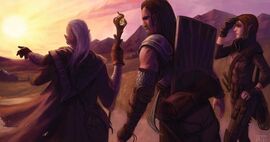
An elven mage and companions
Among non-humans, attitudes towards magic vary. The Dalish elves are, for all intents and purposes, the most accepting of their mages. Dalish believe that magic is a gift of the Creators[54] and that study of magic is key to rediscovering their lost history.
They do, however, acknowledge the inherent danger of magic, and take strides to reduce the risk, as well as avoid incurring the wrath of the templars. Dalish clans are known to exchange their mages if it seems like one clan has too many or too few, so no clan is left without any,[55] though some clans have gone as far as to cast out extraneous mages to survive, or die, on their own.[56] While some have claimed that Dalish clans limit the number of their mages to three, other clans have been said to have more than that at a given time.[57] Mage children will be personally instructed by their clan's Keeper, and if they demonstrate sufficient aptitude will be elevated to be the Keeper's First (or Second), an apprentice expected to one day become the clan's new Keeper.
Every Dalish clan is sworn to protect its Keeper to the death, and should the Keeper fall to demonic possession, the clan is bound to hunt and slay the Keeper. This happens rarely, however, as most Keepers are wise and careful enough to never make deals with demons or use blood magic.
Dalish magic tends to be more practical and subtle than Circle magic, shaped by the existence of the Dalish.[58] It is often turned to healing and herbalism and tends to be more focused on natural forces. Dalish mages do not generally use any magic involving spirits, as they believe them to be inherently dangerous.[59]
The ancient magic of "Veilfire" is also an elven art, though not specifically a Dalish one. Often used like a torch, veilfire is able to reveal hidden messages and gain impressions of past events, as well as illuminate dim passages... often with the accompanying unearthly whispers of the Fade. According to Solas, "it is a form of sympathetic magic, a memory of flame that burns where the Veil is thin."
Qunari[]
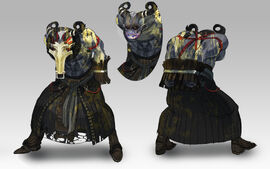
A saarebas concept
- See also: Qunari#Magic
On the opposite end of Thedas, the Qunari, bound to order, have virtually no tolerance for mages, which they call saarebas (literally "dangerous thing"). Those among them who are found to possess magical ability are kept on leashes by special soldiers called arvaarad, and fitted with blinders. Their horns are sheared off and in extreme cases their lips may be stitched together. If a saarebas is found practicing forbidden magic, their tongues are cut out to prevent them from corrupting others.[60] Despite these measures, the Qunari pity and honor the saarebas as they believe that their striving while under constant threat from within is truly selfless and that is the highest virtue of the Qun.[61]
Surprisingly, the mages themselves accept their condition without question, as they manage to find some measure of solace within the Qun, since they believe there is a purpose to their existence, even if it means the loss of their freedom. If separated from their arvaarad, they are willing to accept death as they may be corrupted and not even be aware, presenting a danger to themselves and others, as was the case for Ketojan. They pity other mages who are not Qunari, because they will surely doom themselves and everyone who they come in contact with.
Rivain[]
The Rivaini, unlike the majority of peoples in Thedas, are not andrastians and don't believe in the Maker. Rather, they are pantheists who believe in the Natural Order. As such, many hold to the belief that their god and the universe are the same.[62] Many, especially in Kont-aar, have also converted to the Qun, as their religion and the Qun are not very contradictory. According to Ferdinand Genitivi, a well-known Chantry scholar, "The Chant of Light never truly reached the ears of these people. Resistance to the Chant goes deeper than the Qunari Wars. The Rivaini refuse to be parted from their seers, wise women who are in fact hedge mages, communicating with spirits and actually allowing themselves to be possessed. The Chantry prohibition against such magical practices violates millennia of local tradition."[62]
Though a Circle existed in Rivain, it was merely a means to appease the Chantry. The mages of the Circle were allowed to see their families and the women were specifically trained to be seers, a position in Rivaini society that is revered as a matter of tradition. These local hedge witches converse with spirits and even allow themselves to be possessed, though it is supposedly done so for the benefit of their villages.[63]
Tevinter[]
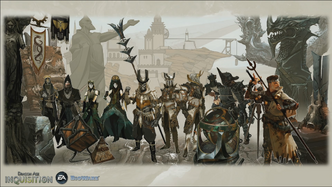
Tevinter Concept Art
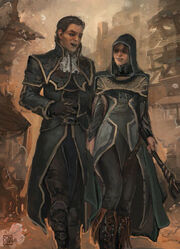
Tevinter Mages
The native culture in the Tevinter Imperium is that magic is considered a mark of honor, especially for those who are powerful enough and adept to use it to their advantage. Tevinter has its own Imperial Chantry and many of its mages are the scions of its ancient noble bloodlines, who have long nurtured the magic in their genealogy. Even Tevinter commoners view magic as a gift and a part of their culture, so mages are respected across all social classes more than in other countries. In fact, the hope that their offspring or descendants will be born a mage and thus raise the family's social status keeps the commoners placated.
Due to the Imperium's rooted history with magic, the descendants of Tevinter's elite, even after converting to Andrastian teachings, still retained their power and influence but their appreciation of magic conflicted with the Chantry's fear of magic. This inevitable conflict in beliefs led to a schism in ideology between the Tevinter Chantry and the Orlais Chantry. The Tevinter Chantry argued that the Chant of Light's commandment, "magic exists to serve man, and never to rule over him," meant that magic must serve the greater good. They believed that this could be accomplished by freeing Magi to take part in government. After the Imperial Chantry broke away from the Orlesian Chantry's influence, mages were allowed to assume their place as the true rulers of the nation once again.
Though mages rule Tevinter, not all mages are equal. Where one falls in the social hierarchy is dependent on where one falls in Tevinter's social ladder. If a mage isn't born in the right family, chances are they don't rule anything. Tevinter Circles of Magi are prestigious academies, not mage prisons. Yet admittance to a Tevinter Circle is a privilege, not a right.[61] The mages in Tevinter aspire to be magisters: the true rulers of the Imperium. Obtaining status and influence in the Tevinter Imperium is highly competitive however and thus often breeds practices of greed, corruption, and blood magic. Those without magic are trampled underfoot and forced to serve. Behind closed doors, slaves are sometimes sacrificed to fuel a magister's forbidden magic. Even some mages are not spared, for in mages as in all humans, there exists a spectrum—on one end, the very powerful, on the other, those that can barely light a candle. The Empire cares only for the strongest, and those who do not compare favorably are thrown to the wolves.[64]
Slaves and Liberati, particularly elves, who demonstrate magical ability are furthermore able to join the Circle of Magi and the lowest rungs of mage society. This applies as well to the children of elven slaves, and facilitates a dubious sense among them of a "meritocracy" within Tevinter even amongst the lowest classes. However, even for those gifted elven slaves who are able to join the magocracy, there is still an element of racism that creates obstacles beyond being seen as a fellow mage. Furthermore, mundane slaves cannot, of course, take part in this meritocratic system any more than any other non-talented citizen can.[65]
According to Fenris, though magisters claim that blood magic is forbidden, it's no secret that any Tevinter mage of rank secretly practices it or at least are proficient in its use. This is also confirmed by Lambert and Dorian. However, what is considered blood magic in Tevinter is different from what other Andrastian nations consider blood magic. Still, even what Tevinter considers forbidden magic is practiced by the upper echelon behind closed doors in order to maintain their edge against their adversaries. Even accusing other mages of being maleficar is often misused as another method for mages to get rid of their rivals.
In spite of some abuse of magic, Tevinter mages are less prone to demonic possession when compared to those in the South. Tevinters claim that the difference is one of acceptance and education. In Tevinter, a mage child is celebrated. Their magic is a gift, and they are taught—with objectivity—how to use it. They are shown possibilities, not just pitfalls. Where as southern mages believe every spell they cast may open them to possession, every magical action becomes fraught. Thus their fear and ignorance limits the southern mages' capabilities.[66]
Hedge Mages[]
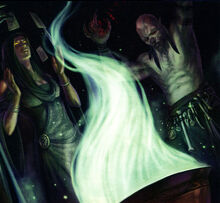
Apostate mages[67]
- Main article: Hedge mage
Hedge mages are untrained magic-users who wield powers developed outside of conventional teaching[68] of the Circle of Magi and because of this, they are all apostates. Some of these hedge mages are not even aware of their nature. Undeveloped, their abilities can express themselves in a variety of ways, which the hedge mage might attribute to faith, or will, or to another being entirely (depending on the mage's nature).[43]
More specifically hedge magic, known by its more technical name "arcanist derangement"[69] among mages and scholars, is a form of magical expression different than that of typical mages. The term was coined by Magister Allineas at the height of the Towers Age. The magister posited that magical talent is like a flowing river. When expressed through a mage, it finds a proper outlet through spellcraft. Left to its own devices it flows unexpectedly, and thus hedge mages are created. Prior to the creation of the Circles, such magical talent expressed itself often through ancient traditions and rituals. Those mages possessed powers that no Circle spell could replicate and their unpredictable ability was deemed a threat.
Hedge mages live chaotic lives, able to commune with spirits, lured into darkness and temptation and sometimes even insanity. Their lives are often short as a result of this wild talent. The term "arcanist derangement" reflects this propensity toward madness in such mages.[70]
The term "hedge mage" was created as a derogatory term by the Chantry.[69]
Notable mages[]
- For a complete list, see Category:Magi.
- Anders
- Baroness
- Bethany Hawke
- Clarel de Chanson
- Dorian Pavus
- Flemeth
- Feynriel
- Francesca Invidus
- Hawke (if played as Mage)
- Irving
- Jowan
- Maevaris Tilani
- Malcolm Hawke
- Marethari
- Merrill
- Morrigan
- Orsino
- Rook (if played as Mage)
- Rhys
- Solas
- Tarohne
- The Warden/The Warden-Commander (if played as Mage)
- The Inquisitor (if played as Mage)
- Uldred
- Velanna
- Vivienne
- Wynne
- Zathrian
Codex entries[]
Trivia[]
- While there is a genetic component to being a mage, even identical twins do not necessarily share magical ability, in that one sibling might be a mage but not the other.[71]
- Referring to mages as "robes"[72] or "spellbind"[73] is an insult.
- Though hedge mages are generally not respected by enchanters in the Circle of Magi, their untutored power can be incredible nevertheless.[74]
References[]
|
| ||||||||||||||||||||

